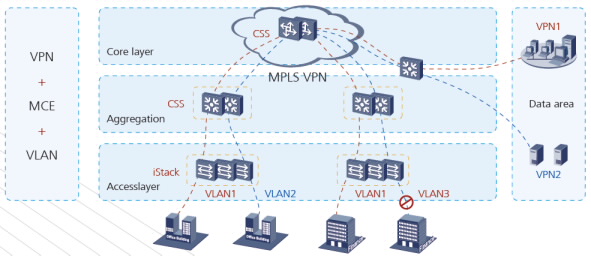Enterprise networks are increasingly complex, carrying a wide variety of services to a variety of end points and devices. Increasingly enterprises are looking to virtualization as a way of helping them increase the overall efficiency of how resources are used both within and across networks while reducing capital and operational costs. Virtualization can help enterprises centralize services and security policies without sacrificing performance, scalability, or user experience. Additionally virtualization can help enterprises handle the challenges associated with managing, securing and troubleshooting a growing number and variety of devices accessing the network.
Huawei One Net virtual campus network solution was designed to help enterprises meet these challenges.
Huawei One Net virtual campus network solution supports network architecture virtualization and service virtualization.
Network Architecture Virtualization
Traditionally, a campus network consists of the access layer, aggregation layer, and core layer. Each network layer has different functions, and services are transmitted across the three layers. As the campus network gradually increases its architecture will become more and more strained making it more difficult to manage the network and deploy services. Simplifying the network architecture can minimize the changes needed as the network grows and simplify service and application development.
Network virtualization can be horizontal or vertical:
- Horizontal virtualization virtualizes multiple physical devices into a logical device. It simplifies the network architecture and provides flexible scalability. iStack technology (used at the access layer) and Cluster Switch System (CSS) technology (used at the aggregation layer) both virtualize physical devices into a logical device. With iStack and CSS, horizontal virtualization greatly reduces the number of links at the access and aggregation layers, and prevents loops without deploying cumbersome protocols like the Multiple Spanning Tree Protocol (MSTP).
- Vertical virtualization virtualizes a logical network into multiple independent logical networks, and is often used in combination with virtual private network (VPN), Multi-VPN-Instance CE (MCE), and VLAN technologies.

Figure 1 Network architecture virtualization
Service Virtualization - Reducing CAPEX and OPEX
The campus network requires enhanced security so that it can transmit services efficiently and reliably, however deploying firewalls on each enterprise or branch of a campus network can be expensive. To combat this, virtual firewall (VFW) technology divides a physical firewall into thousands of virtual firewalls concurrently, thereby providing enhanced security across multiple private networks. VFW technology meets security requirements on private networks, maximizes return on investment (ROI), and reduces capital expenditure (CAPEX).
Huawei One Net virtual campus network solution uses NAT multi-instance and Smart Link multi-instance to better centralize configurations and manage multiple VPNs. These load balancing methods significantly reduce deployment and maintenance workloads and operating expenditure (OPEX).
Huawei has deep expertise in the development, architecture, deployment and operation of virtualization technologies. Huawei offers a broad range of products, solutions and services to meet the needs of small, mid-sized and large enterprises.

